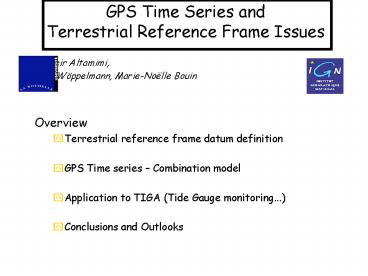GPS Time Series and Terrestrial Reference Frame Issues - PowerPoint PPT Presentation
1 / 32
Title:
GPS Time Series and Terrestrial Reference Frame Issues
Description:
'A priori' vs 'A posteriori' Datum Definition. Stations present in the 'a priori' and 'a posteriori' datum : black circles and labels ... – PowerPoint PPT presentation
Number of Views:28
Avg rating:3.0/5.0
Title: GPS Time Series and Terrestrial Reference Frame Issues
1
GPS Time Series and Terrestrial Reference Frame
Issues
Zuheir Altamimi, Guy Wöppelmann, Marie-Noëlle
Bouin
- Overview
- Terrestrial reference frame datum definition
- GPS Time series Combination model
- Application to TIGA (Tide Gauge monitoring...)
- Conclusions and Outlooks
2
(No Transcript)
3
(No Transcript)
4
(No Transcript)
5
(No Transcript)
6
(No Transcript)
7
(No Transcript)
8
(No Transcript)
9
(No Transcript)
10
Application to TIGA
- TIGA-PP GPS Tide Gauge Benchmark Monitoring
IGS Pilot Project - Scientific outcomes
- Vertical positions of TGBMs with cm accuracy
(Satellite calibration) - Vertical velocities with better than 1 mm/yr
accuracy for a subset of sites (Long term trend
sea-level studies) - Technical issues
- set up the required research infrastructure to
handle the problem at the global scale, i.e. - Observing Stations
- Dedicated Data Centres
- Different types of Analysis Centres process GPS
data...
11
Current processed CGPS_at_TG network at ULR121 TG
(including 7 RF) 15 RFTime span 2000/002 -
2002/323
12
Data Analysis Strategy (1)
- Software
- GAMIT (R. King, MIT) GPS data processing
- CATREF (Z.Altamimi, IGN) Solutions combination
- General
- Standards proposed by TIGA Adopted
- Basic observable Double Difference carrier
phases - Elevation cut-off angle 10
- Niell mapping function ZPD estimated every 2
hours - Ocean loading corrections Scherneck Bos
- IGS final orbits transformed into ITR2000
(R.Ferlands procedure)
13
Data analysis strategy (2)
- GPS solutions and Reference frame realisation
- Daily Processing is split in 4 global networks of
less than 50 stations - Each network includes a subset of the 55 IGS RF
stations - The 4 Network solutions are combined to get ONE
global daily solution using the Minimal
Constraint Approach (Altamimi et al, 2002) - Daily solutions are then combined to get the
weekly solutions - Reference frame stations selected on ITRF2000
results - Stations available from at least 3 individual ACs
- Minimum of 2 years of GPS data available
- ?X lt 3 mm , ?V lt 1 mm/yr in ITRF2000
- ITRF2000 Residuals lt 1.5 mm in Horizontal, ... lt
2.5 mm in Vertical - ... lt 1.5 mm/yr in
Horizontal, ... lt 2.5 mm/yr in Vertical
14
IGS Reference Frame Stations (55)
15
Datum definition - Reference Frame Stations (22)
- Stations available from at least 3 individual
Acs - Minimum of 2 years of GPS data available
- ?X lt 3 mm , ?V lt 1 mm/yr in ITRF2000
- Residuals lt 1.5 mm in Horizontal, ... lt 2.5 mm
in Vertical, ... lt 1.5 mm/yr in Horizontal, ...
lt 2.5 mm/yr in Vertical
16
Weekly time series solutionsCombination and
Analysis (1)
17
Careful Time Series Inspection
- Discontinuities
- Venice (2001/031)
- Maldives (2000/152)
- San Fernando (2002/065)
- La Coruna (2002/157)
- Cocos Isl. (2000/187)
- Churchill (2002/058)
- Outliers (corrected...)
- ...
18
(No Transcript)
19
Weekly time series solutionsCombination and
Analysis (2)
20
Datum (Re-)definition on current results (21)
- Solutions available for at least 90 of the
total time span - Station within the ITRF2000 solution
- Careful inspection of time series residuals on
East, North and Up components
21
"A priori" vs "A posteriori" Datum Definition
- Stations present in the "a priori" and "a
posteriori" datum black circles and labels - New Reference Frame Stations (after analysis)
red circles and labels - Former Reference Frame Stations blue stars
22
A look at some "dismissed" RF stations
23
A look at some "dismissed" RF stations
24
Weekly time series solutionsCombination with the
new Datum
Old RS
New RS
25
Some promising results
26
Some promising results
27
Some promising results
28
Some promising results
29
Some promising results
30
Conclusions and Outlooks
- Minimum Constraints approach is an efficient way
for TRF definition - Reference Frame Stations are of primary
importance for TRF long-term stability - Analysed Data Span is still too short
- To derive reliable/accurate vertical trends
- To stabilize the TRF
- To estimate seasonal variations
- To compare with TG time series
- TIGA is a research project !
31
Seasonal Variations
Before
After
32
(No Transcript)































